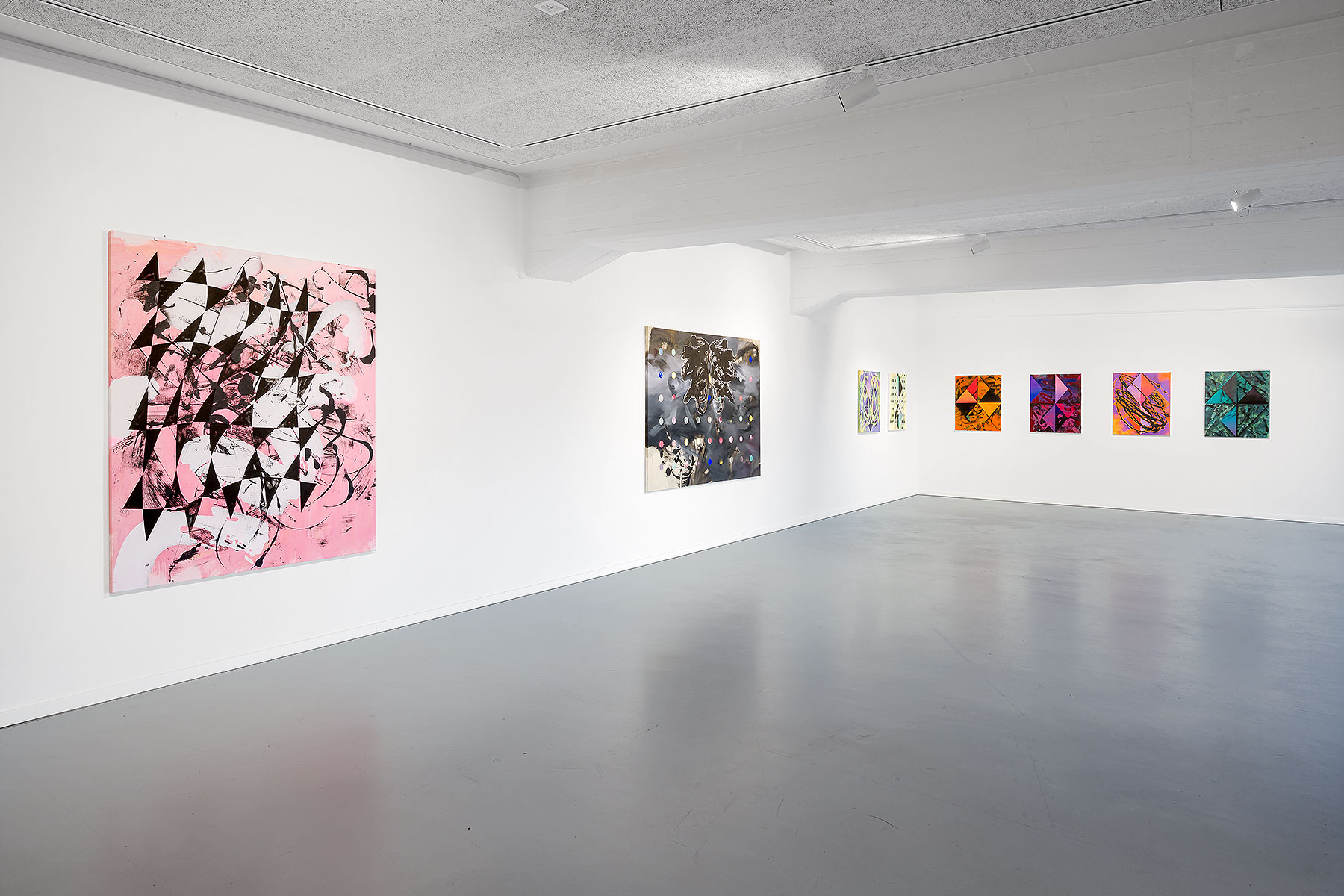
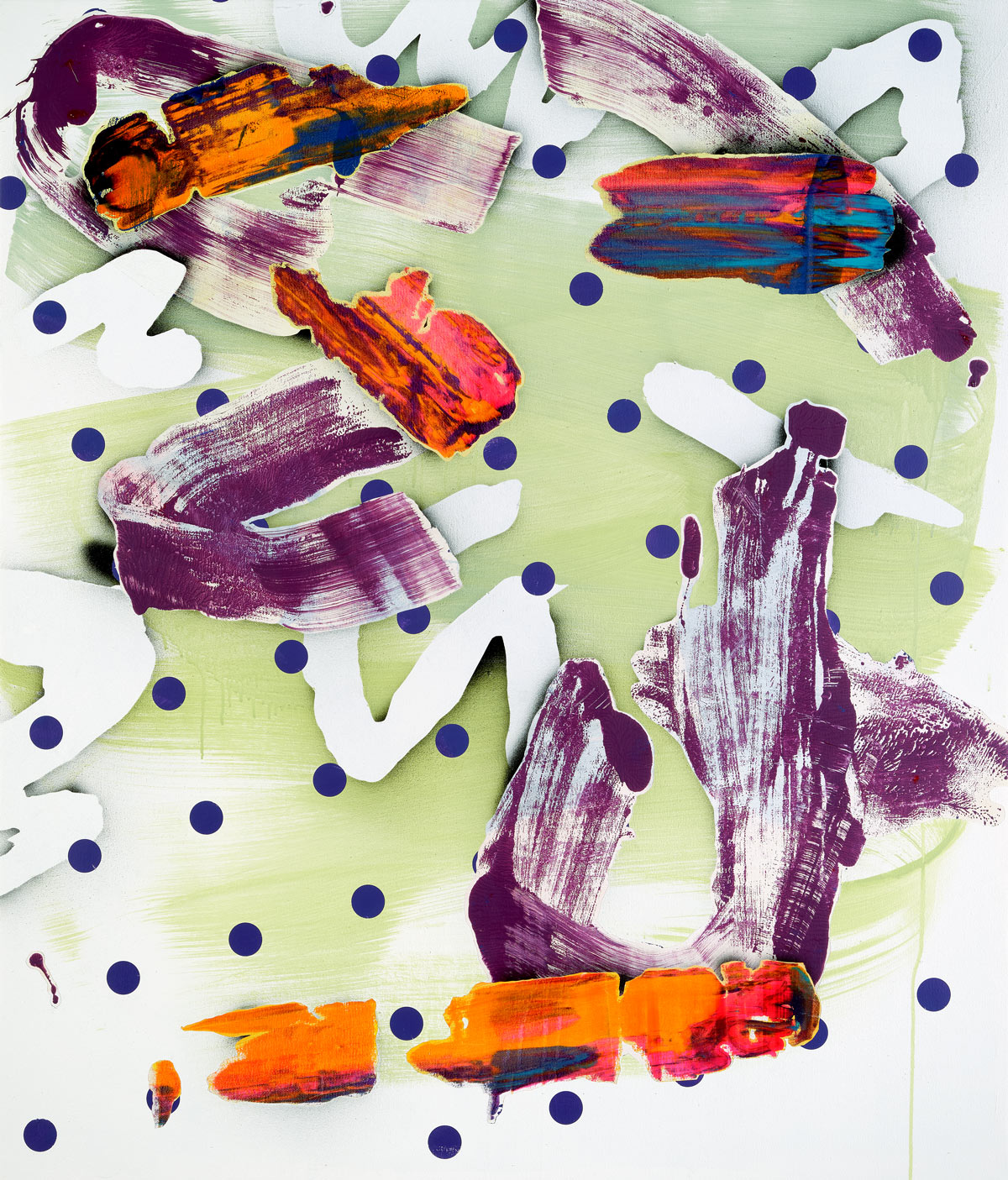
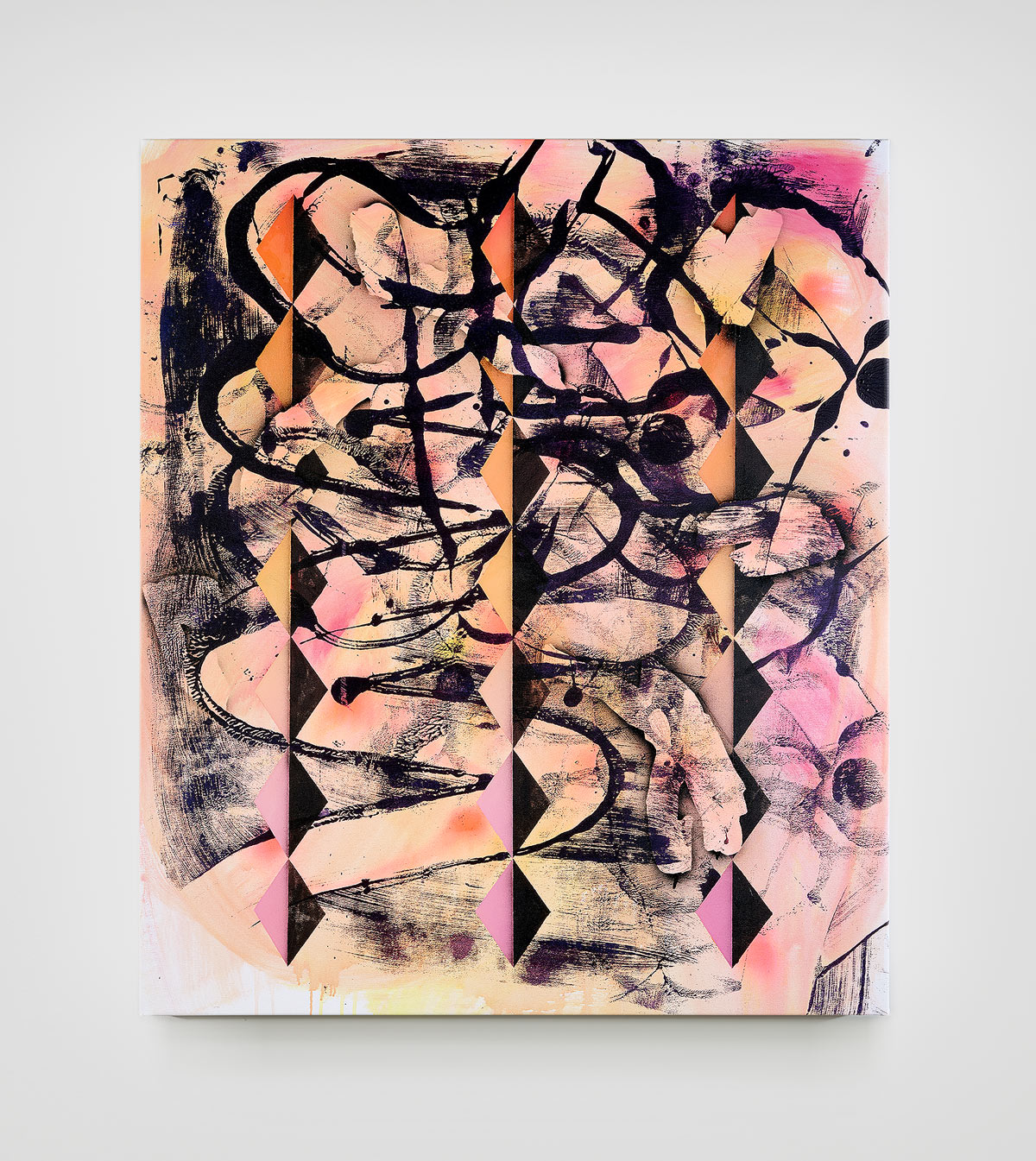
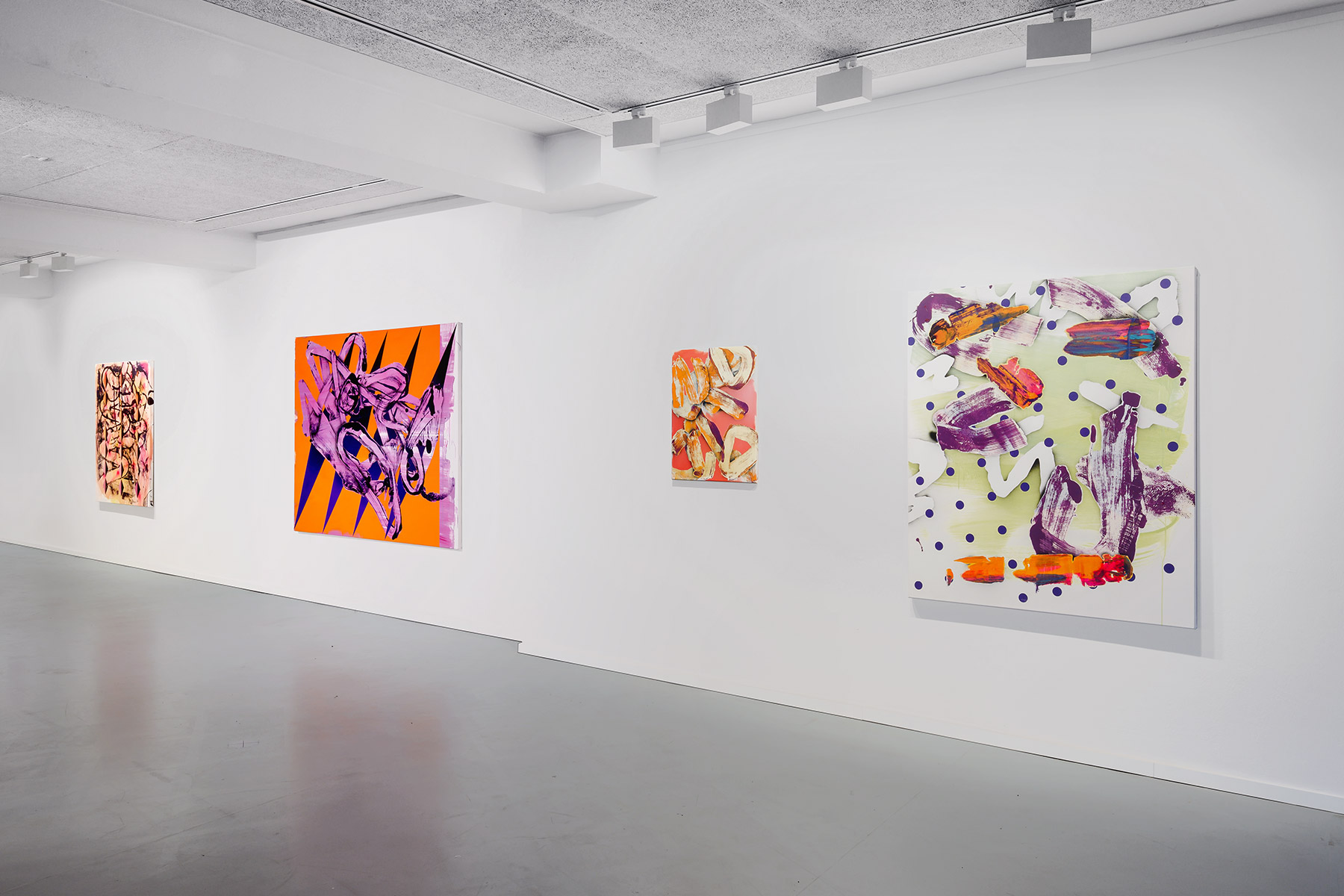
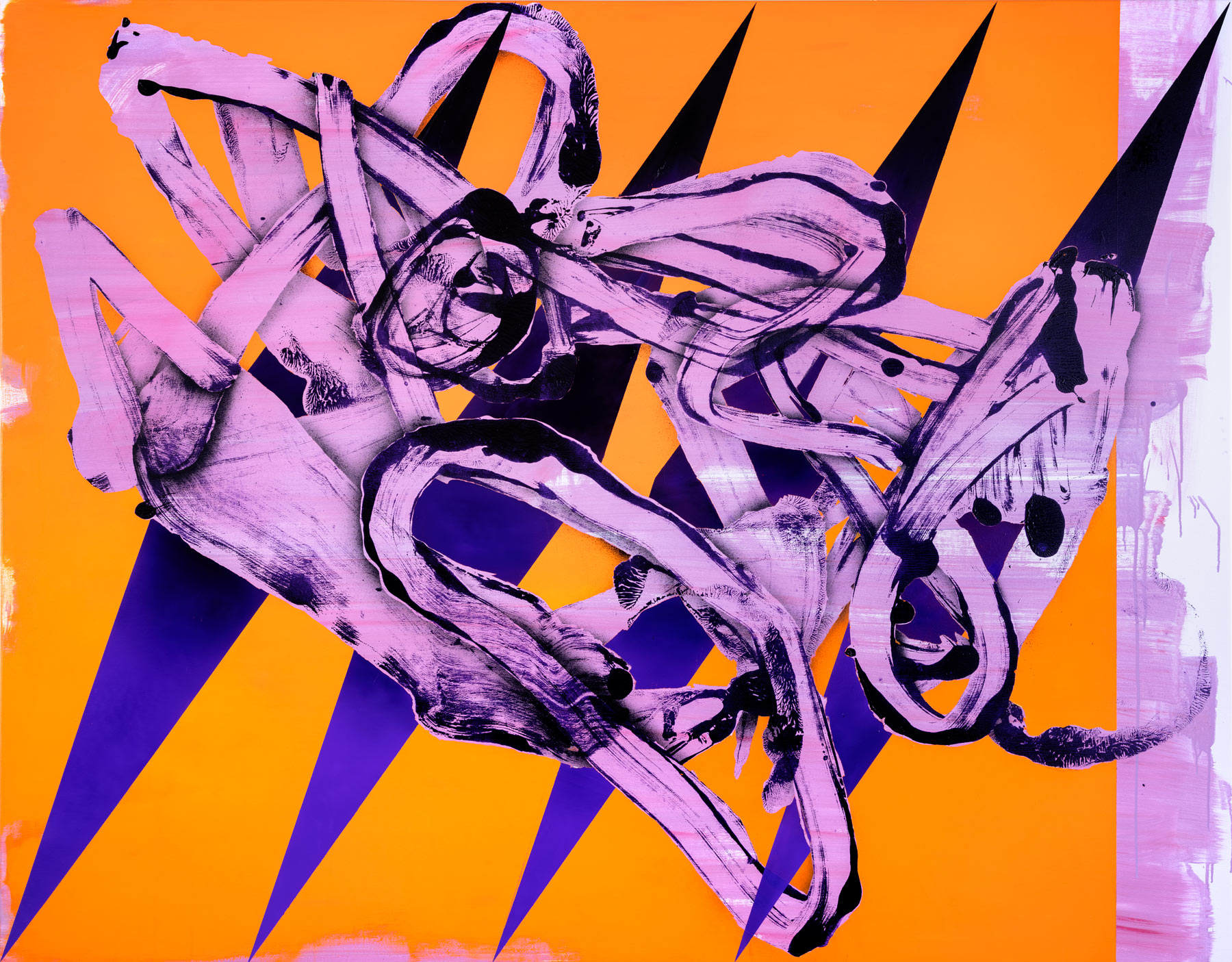
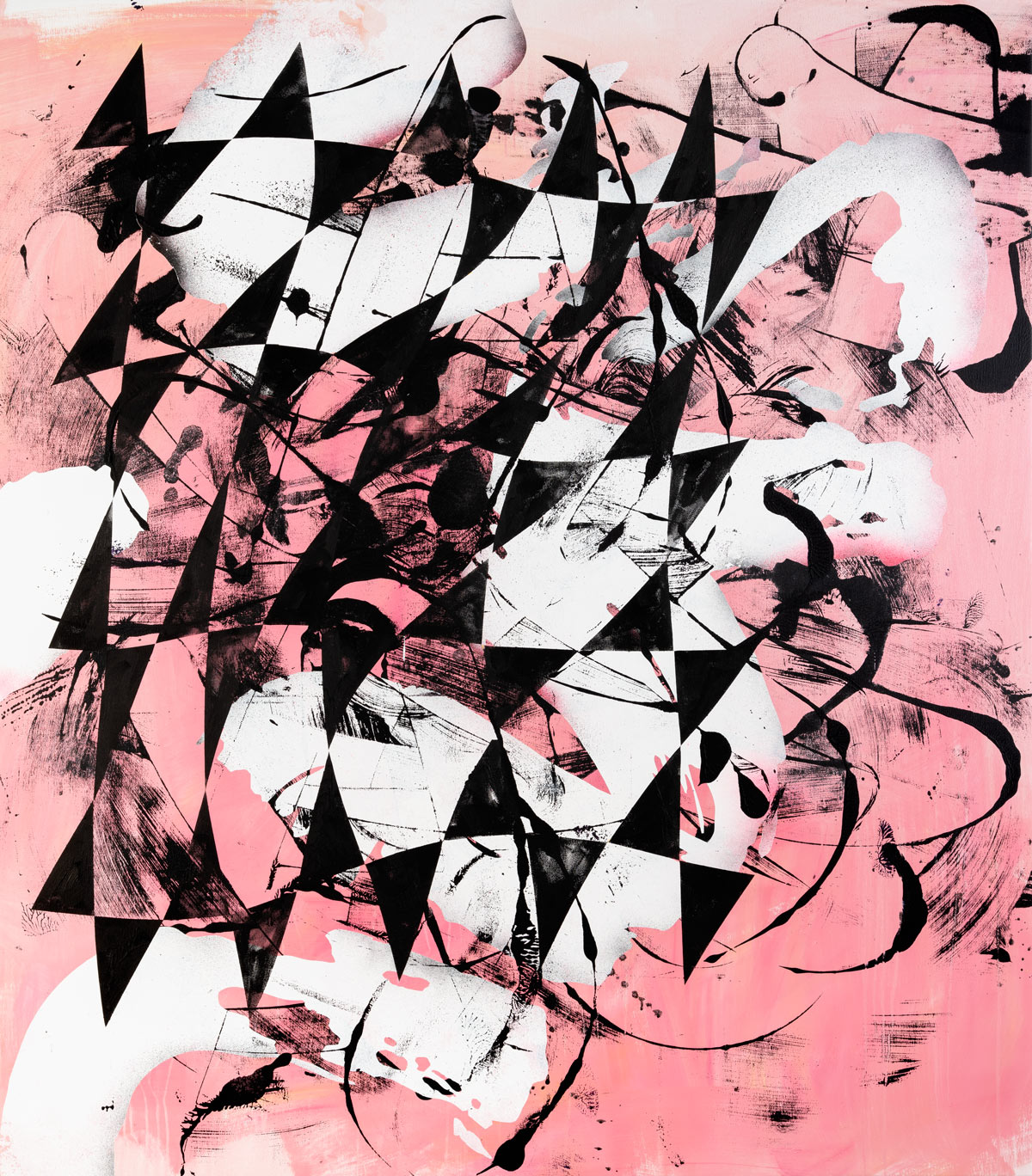
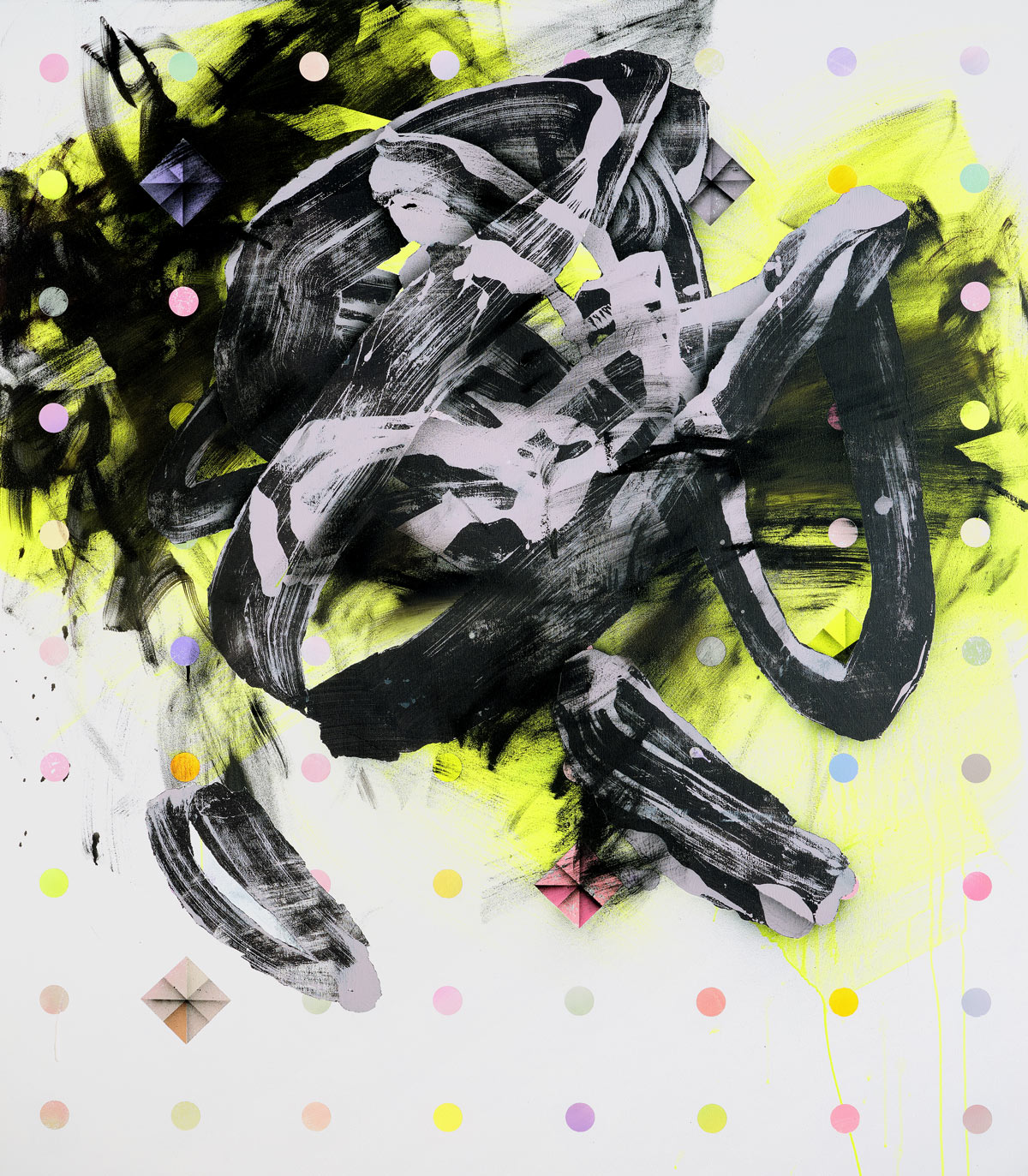
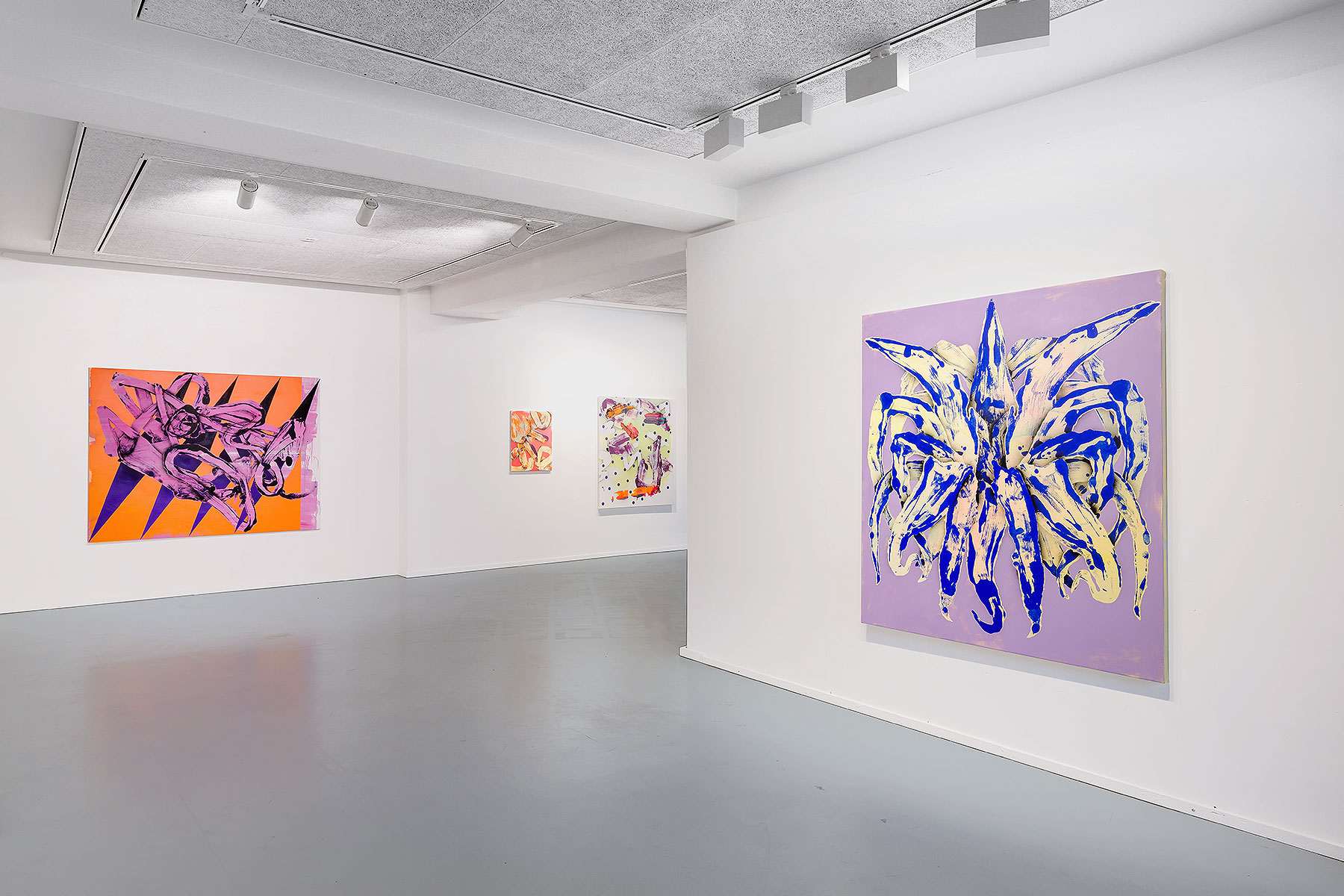
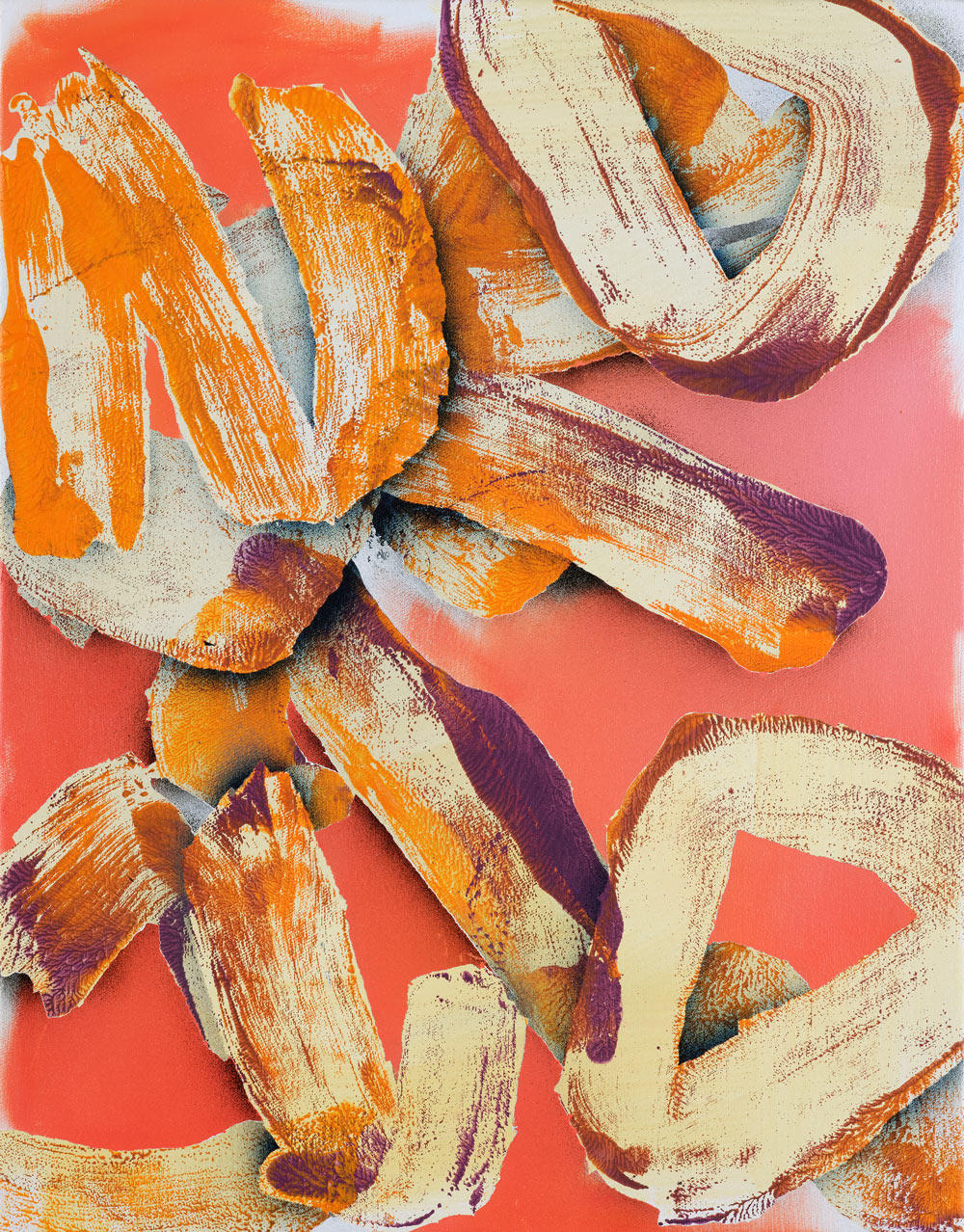
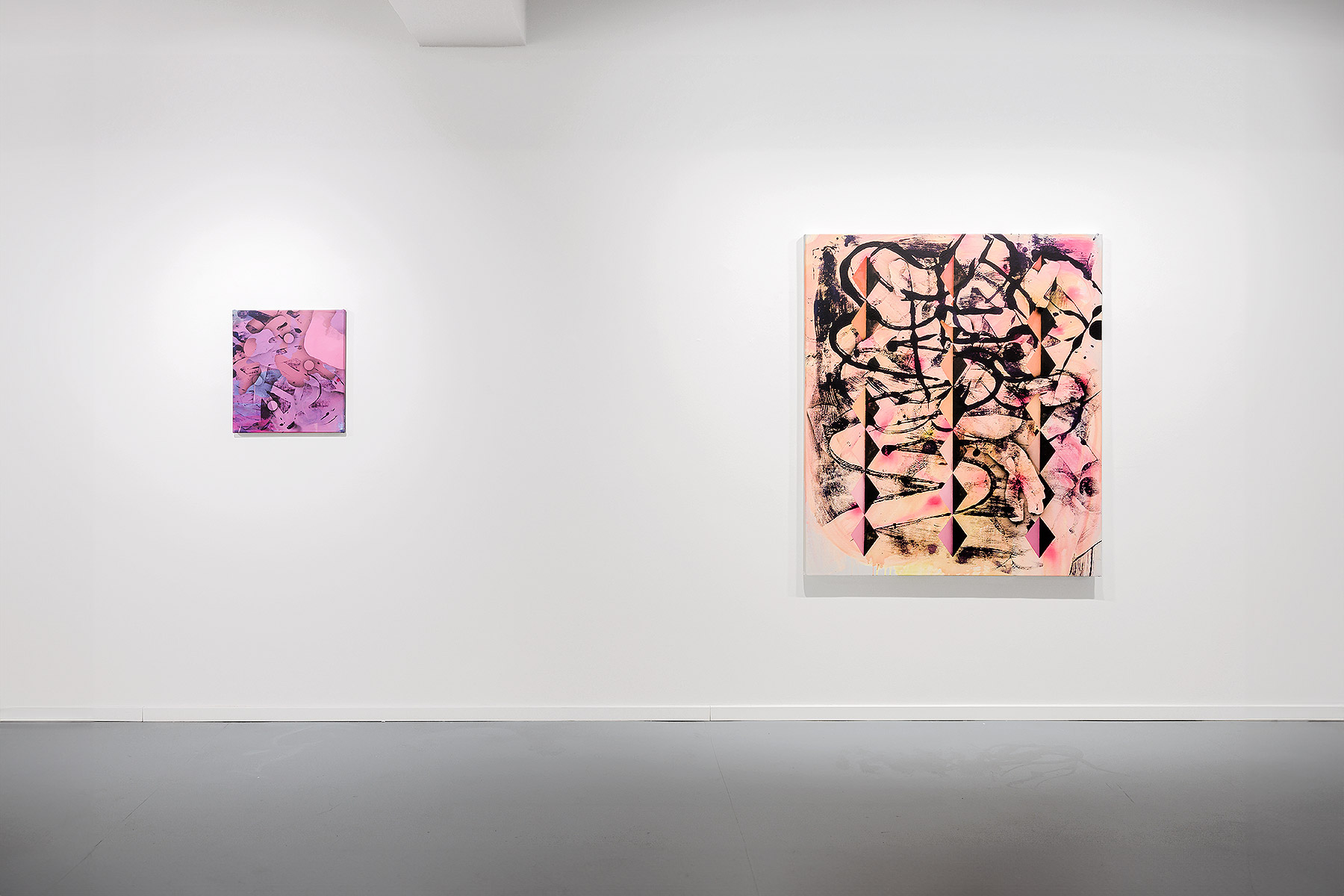
Struktur und Statik einerseits, Wirbel und Dynamik andererseits: Malwin Faber kombiniert in seinen Gemälden Gegensätze, die in der Moderne als unvereinbar galten, die geometrische und die gestische Abstraktion. Steht das eine für objektive Ordnungen, so das andere für den subjektiven Selbstausdruck des Künstlers.
Von den russischen Konstruktivsten bis zu De Stijl, von Kasimir Malewitsch bis zu Theo van Doesburg verbindet sich mit der Geometrie die Idee eines metaphysischen Prinzips. Künstlerische und kosmische Ordnung entsprechen einander in den geometrischen Grundformen: Sie stehen für den Bauplan der Welt. Die gestische Abstraktion hingegen verweist von Kandinskys „Improvisationen“ bis zu den „Drippings“ Jackson Pollocks auf den Künstler, auf sein Inneres, sie gilt als expressiv und emotional.
Faber löst diese Zuschreibungen auf. Die geometrischen Raster und Rauten werden durchbrochen von expressiven Pinselschwüngen, die ihrerseits von den geometrischen Strukturen durchsetzt sind. Die Ordnung wirkt chaotisch, das Chaos eigentümlich geordnet. Mathematische Präzision und künstlerische Improvisation, das Rationale und das Irrationale, sind unauflöslich miteinander verklammert. Dieser Effekt wird verstärkt durch eine Raumordnung, die das Davor und Dahinter verunklärt: Die planparallelen Bildebenen durchdringen einander, was zuunterst sein sollte, erscheint obenauf und umgekehrt. Faber erzielt diesen Effekt, indem er einzelne Partien im Laufe des Malprozesses abklebt und sie später wieder freilegt.
Deshalb wirken auch die gestischen Pinselschwünge seltsam sinnentleert. Sie verweisen eben nicht mehr auf den spontanen künstlerischen Selbstausdruck, sondern werden zur buchstäblich leeren Form, in denen die darunter liegenden Schichten sichtbar bleiben. Ihre Binnenstruktur folgt nicht den Borsten des Pinsels, die füllende Form widerspricht der äußeren Kontur: Sie wirken vielmehr wie Ausschnitte, die den Blick freigeben auf Strukturen, die sichtbar anders entstanden sind. Faber konturiert diese Pinselschwungformen, setzt hell und dunkel kontrastierende Farben hinzu, um ihre Kanten zu betonen und sie wie durch Schattenfugen abgesetzt auf der Bildfläche schweben zu lassen.
Dieser regelrechten Dekonstruktion des Pinselstrichs als Authentizitätsgaranten einer unmittelbaren spontanen Selbstäußerung, einer expressiven, ‚echten‘, emotionalen Malerei entspricht auf der anderen Seite eine Destabilisierung der geometrischen Struktur, die sowohl die Bildfläche als auch den Bildraum organisiert. Rauten und Rasterpunkte werden von den Pinselschwüngen überlagert und durchkreuzt, ja, teilweise scheinen sie sich gegenseitig auszulöschen, heben einander aber auch hervor.
„Resonanzfrequenzen“, der Titel dieser Ausstellung, bringt dieses Oszillieren zwischen Statik und Dynamik, Ordnung und Chaos, Davor und Dahinter, Raum und Fläche, von subjektivem gestischem Selbstausdruck und objektiver geometrischer Struktur auf den Punkt: Die „Frequenz“ beschreibt die Geschwindigkeit einer sich wiederholenden Schwingung, die sowohl das geometrische Raster als auch die gestische Form erfasst.
Nicht nur sind die geometrischen Strukturen regelmäßig, auch die gestischen Formen schwingen um ein Zentrum herum wie der Ausschlag eines Pendels und werden bisweilen sogar gespiegelt wie im Rorschachtest. Der in der Geometrie sich zeigende ideelle Bauplan der Natur als Sinnbild kosmischer Systematik zeigt sich auch dort, wo das Irreguläre eigentümlich regulär wird, den Achsen- und Spiegelsymmetrien der gestischen Pinselformen, die Faber auch in der Natur wiederfindet: Der gleichsam regelhafte, aber nicht regelmäßige, achsensymmetrische Wuchs der „Agave“ scheint wie eine Natur gewordene künstlerische Formation gestischer Pinselschwünge, gespiegelt wie im Rorschachtest.
Regel und Abweichung, System und Variation verweisen auf das schöpferische Potential einer sich stets neu erfindenden Natur wie auch einer, analog zu dieser gedachten, wahrhaft kreativen Kunst. Um dieses Zentrum schwingen die beiden eigentlich so gegensätzlichen Systeme des Geometrischen und des Gestischen, sie schwingen auch miteinander, antworten aufeinander und regen einander an, in ihrer formalen Verschiedenartigkeit wie auch ihrer rhythmischen Ähnlichkeit: Sie erzeugen eine wechselseitige Resonanz.
Resonance Frequencies
© Veronika Schöne
Translation: Andrew Irvin
Structure and static on the one hand, whirls and dynamics on the other: Malwin Faber combines opposites in his paintings that were considered incompatible in modern art: geometric and gestural abstraction. While one represents objective order, the other embodies the artist's subjective self-expression.
From the Russian constructivists to De Stijl, from Kazimir Malevich to Theo van Doesburg, the idea of a metaphysical principle is connected with geometry. Artistic and cosmic order correspond to each other in geometric basic forms, representing the blueprint of the world. On the other hand, gestural abstraction, from Kandinsky's "Improvisations" to Jackson Pollock's "Drippings," refers to the artist's inner self, seen as expressive and emotional.
Faber breaks down these attributions. Geometric grids and diamonds are disrupted by expressive brushstrokes, which are in turn intersected by the geometric structures. The order appears chaotic, and chaos becomes peculiarly organized. Mathematical precision and artistic improvisation, the rational and the irrational, are irreversibly intertwined. This effect is enhanced by a spatial arrangement that blurs the foreground and background: the parallel image planes penetrate each other, causing what should be at the bottom to appear on top and vice versa. Faber achieves this effect by masking individual areas during the painting process and later revealing them.
As a result, the gestural brushstrokes appear strangely devoid of meaning. They no longer point to spontaneous artistic self-expression, but become literally empty forms, revealing the layers underneath. Their internal structure does not follow the bristles of the brush, and the filling form contradicts the outer contour. Instead, they seem like excerpts that allow a glimpse of structures that were visibly created differently. Faber outlines these brushstroke forms, adding contrasting bright and dark colors to emphasize their edges, making them appear as if floating on the picture surface through shadow joints.
This deconstruction of the brushstroke as a guarantor of authenticity for immediate spontaneous self-expression, an expressive, 'genuine,' emotional painting, is accompanied by a destabilization of the geometric structure that organizes both the picture surface and the pictorial space. Diamonds and grid points are overlaid and crossed by the brushstrokes, at times appearing to cancel each other out, yet also highlighting one another.
"Resonanzfrequenzen (Resonance Frequencies)", the title of this exhibition, encapsulates this oscillation between static and dynamic, order and chaos, foreground and background, space and surface, subjective gestural self-expression, and objective geometric structure: The "frequency" describes the speed of a repetitive vibration that encompasses both the geometric grid and the gestural form.
Not only are the geometric structures regular, but the gestural forms also oscillate around a center, like the swing of a pendulum, and are sometimes even mirrored, as in a Rorschach test. The ideal geometric blueprint of nature as a symbol of cosmic systematically also manifests itself where the irregular becomes peculiarly regular: the seemingly orderly but not uniformly symmetrical growth of the "agave" appears like a nature-transformed artistic formation of gestural brushstrokes, mirrored like in a Rorschach test.
Rule and deviation, system and variation, point to the creative potential of a constantly reinventing nature as well as an art that is truly creative, akin to this imagined nature. Around this center, the two ostensibly opposing systems of the geometric and the gestural sway together, responding to each other and inspiring one another in their formal diversity as well as their rhythmic similarity; they create a reciprocal resonance.